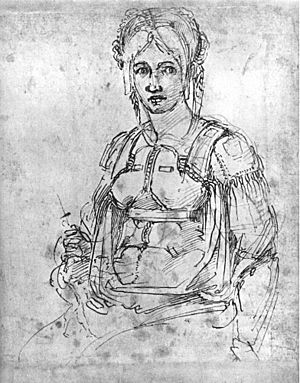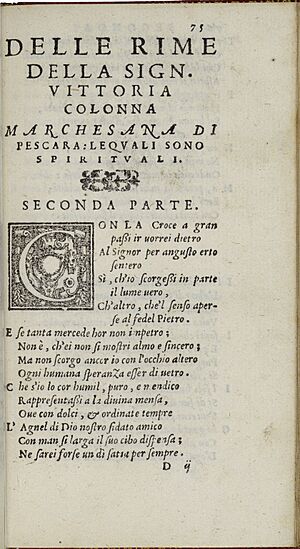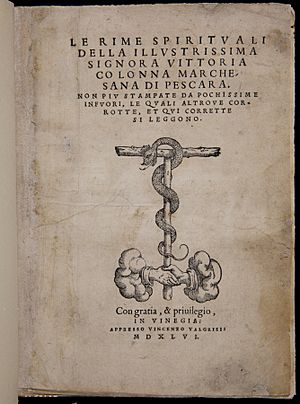Vittoria Colonna facts for kids
Quick facts for kids
Vittoria Colonna
|
|
|---|---|
| Marchioness of Pescara | |

Vittoria Colonna, by Sebastiano del Piombo, c. 1520
|
|
| Born | April 1490 Marino, Papal States (present-day Italy) |
| Died | 25 February 1547 (aged 56) Rome, Papal States (present-day Italy) |
| Noble family | Colonna |
| Spouse(s) | Fernando Francesco d'Ávalos, Marquis of Pescara |
| Issue | Alfonso d'Avalos, Marquis del Vasto (adopted) |
| Father | Fabrizio Colonna |
| Mother | Agnese da Montefeltro |
| Occupation | Poet |
Vittoria Colonna (born April 1492, died February 25, 1547) was a famous Italian noblewoman and poet. She was also known as the Marchioness of Pescara. Vittoria was very well educated. While her husband was away fighting, she became friends with many smart people in Ischia and Naples. Her poems started getting noticed in the late 1510s. She soon became one of the most popular poets in Italy during the 1500s.
After her husband died, she went to live in a convent in Rome. She chose to remain a laywoman, meaning she didn't become a nun. However, she became very religious and stayed that way for the rest of her life. Vittoria Colonna was also a close friend and inspiration to the famous artist Michelangelo. He was a poet too!
Contents
Early Life and Marriage
Vittoria Colonna was born in 1492 in a town called Marino. This town was owned by her family, the Colonna family. It was located in the Alban Hills, close to Rome. Her father was Fabrizio Colonna, a powerful leader in the Kingdom of Naples. Her mother was Agnese da Montefeltro, whose father was the Duke of Urbino.
When Vittoria was only three years old, in 1495, she was promised in marriage. This was to "Ferrante" Fernando Francesco d'Ávalos. He was the son of the Marquis of Pescara. This marriage was arranged by King Ferdinand of Naples.
In 1501, the Colonna family lost their lands because of Pope Alexander VI. So, the family moved to Ischia. This was the home of Vittoria's future husband. In Ischia, Vittoria received a great education. She learned about literature and art from Costanza d'Avalos, her future husband's aunt. Vittoria showed a strong love for reading and writing early on.
Many important people wanted to marry Vittoria. These included the dukes of Savoy and Braganza. But she chose to marry d'Ávalos. They got married on the island of Ischia on December 27, 1509. In Ischia, Vittoria Colonna became part of a group of writers and thinkers. This group was led by Costanza d'Avalos, her husband's aunt.
The couple lived together in Ischia until 1511. Then, her husband joined the fight against the French in the War of the League of Cambrai. He was captured in 1512 at the Battle of Ravenna (1512). He was then taken to France. During his time as a prisoner and the many years of fighting that followed, Vittoria and d'Avalos wrote many passionate letters and poems to each other. However, only one of her poems to him has survived.
Between 1516 and 1522, Vittoria lost three family members. Her younger brother, Federico, died in 1516. Her father, Fabrizio, died in 1520. Her mother, Agnese, died in 1522.
Vittoria and d'Avalos rarely saw each other during their marriage. He was one of the best and most active captains for Emperor Charles V. Vittoria was important enough to stop her husband from joining a plan against the emperor. This was after the Battle of Pavia in 1525. She also made him refuse the crown of Naples. This crown was offered to him if he betrayed the French.
Vittoria spent the summer of 1525 at her father's castle in Marino. She became ill there and suffered from illness for the rest of her life. During this time, she received an early copy of Baldessare Castiglione's famous book, The Book of the Courtier. She shared this book with others in Naples. On September 21, Castiglione wrote her a letter. He was upset that she had let his unpublished work be copied. This made him hurry to publish his book.
Life as a Widow (1525–1547)
On December 3, 1525, Fernando died in Milan. He had been wounded at the Battle of Pavia. Vittoria was rushing to be with him. She heard the news of his death when she was in Viterbo. She stopped and went to the church of San Silvestro in Capite in Rome. There was a convent there. She asked to become a nun and join the convent. But Pope Clement VII and her brother Ascanio said no. They hoped she would marry again to create another important political family connection. Vittoria then went back to Ischia, where she stayed for several years. She refused other marriage proposals and focused on writing poetry.
The Sack of Rome (1527) was a terrible event. It finally helped the Colonna family improve their relationship with Pope Clement VII. They offered help to the people of Rome. But when the French army attacked Naples, the whole Avalos family went to the island of Ischia for safety.
Nine months after Rome was attacked, the historian Paolo Giovio came to Ischia. Vittoria had invited him. He stayed until 1528. During his visit, he wrote a book called Dialogus de viris ac foeminis aetate nostra florentibus. This book is set on Ischia. In the third part of his book, Giovio wrote ten pages praising Vittoria Colonna.
In 1529, Vittoria returned to Rome. She spent the next few years traveling between Rome, Orvieto, Ischia, and other places. She also tried to fix some wrongs her late husband had done. She asked the Avalos family to return some land they had wrongly taken from the abbey of Montecassino.
In 1532, Vittoria Colonna's cousin, Cardinal Pompeo Colonna, wrote a book for her. It was called Apologia mulierum (Women's Apologia). This book argued that women should be able to hold public jobs and positions of power.
In 1535, Vittoria's sister-in-law, Giovanna d'Aragona, separated from Vittoria's brother Ascanio. Giovanna came to Ischia. Vittoria tried to help them get back together. Even though Giovanna refused, the two women became close friends. They supported Juan de Valdés. They also tried to help Ascanio when he refused to pay a salt tax to Pope Paul III.
In 1537, Vittoria was in Ferrara. She made many friends there. She also helped set up a Capuchin monastery. She did this at the request of a reforming monk named Bernardino Ochino. He later became a Protestant.
In 1536, at age 46, she was back in Rome. There, she earned the respect of Cardinals Reginald Pole and Contarini. She also became a very close friend of 61-year-old Michelangelo. The great artist wrote some of his best poems for her. He also made drawings for her and spent many hours talking with her. She even made a special book of spiritual poems as a gift for him. She moved to Orvieto and Viterbo in 1541. This was because her brother rebelled against Pope Paul III. But this move did not change her friendship with Michelangelo. They continued to visit and write to each other.
On May 8, 1537, she arrived in Ferrara with some other women. Her plan was to travel to Venice and then to the Holy Land. Some people believe her goal in Ferrara was to set up a Capuchin monastery for Bernardino Ochino. Vittoria's health made her stay in Ferrara until February of the next year. Her friends convinced her not to travel to the Holy Land. She returned to Rome in 1538.
She returned to Rome in 1544. She stayed, as usual, at the convent of San Silvestro. She died there on February 25, 1547.
Many famous writers were her friends. These included Pietro Bembo, Luigi Alamanni, Baldassare Castiglione, and Marguerite de Navarre. She was also close with many people who wanted to reform the church in Italy. These included Pietro Carnesecchi and Ochino. She died before the big church crisis in Italy became very serious. Even though she supported religious reform, there is no reason to think her beliefs were against the Catholic Church. She never became a Protestant.
Legacy and Influence
For a long time, people thought Vittoria Colonna's poetry was not popular after the 1500s. But her poems have been printed again in every century since then. Often, they have been printed many times. Her love poems, called Rime amorose, even inspired the Spanish-Neapolitan poet Francisco de Aldana.
List of Works
Poetry
Published After Her Death
See also
 In Spanish: Vittoria Colonna para niños
In Spanish: Vittoria Colonna para niños




